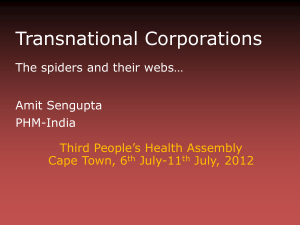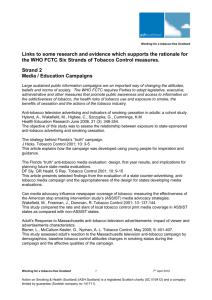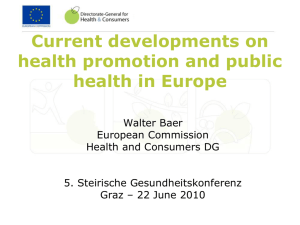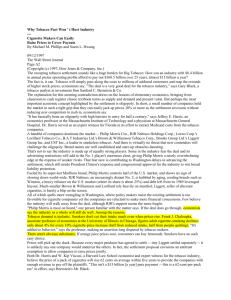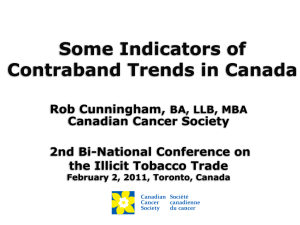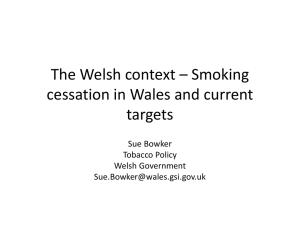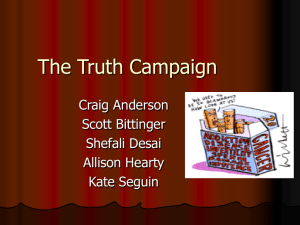described - Corporations and Health Watch
advertisement
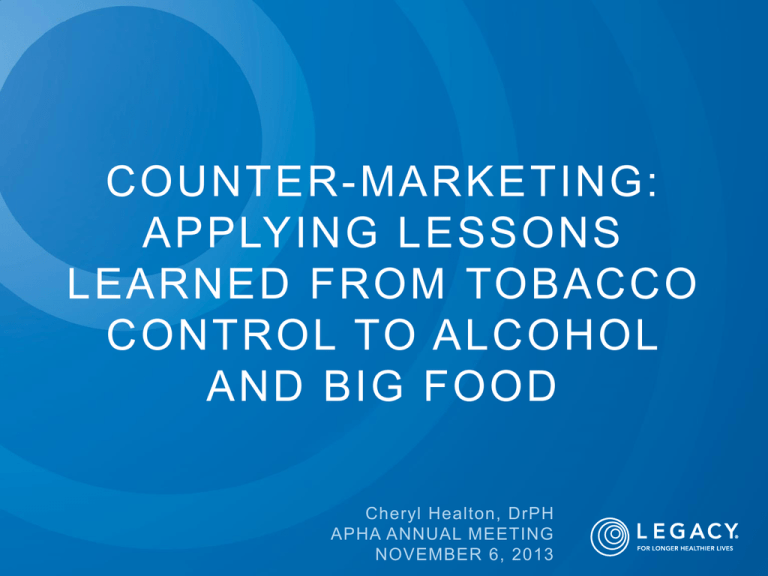
COUNTER-MARKETING: APPLYING LESSONS LEARNED FROM TOBACCO CONTROL TO ALCOHOL AND BIG FOOD Cheryl Healton, DrPH APHA ANNUAL MEETING NOVEMBER 6, 2013 PA R A L L E L TA C T I C S : TO B A C C O , A L C O H O L A N D F O O D 2 TA R G E T I N G Y O U N G W O M E N 3 F O O D A N D FA S H I O N , A L C O H O L A N D WEIGHT 4 TYSONS’ CHICKEN NUGGETS AD 5 THE PROBLEM IS GLOBAL 6 TA R G E T I N G Y O U T H • Extensive formative research is used to develop products and ad campaigns that appeal to the audience ◦ “Alcopops” and caffeinated alcoholic beverages are new products which appeal to youth (Mart, Substance Use and Misuse, 2011) • Food industry can do this openly, unlike tobacco and alcohol; Advertising and sponsorship is prevalent and mostly unchallenged by the public (Daynard, 2002) • Teen Attitude And Behavior Survey (TABS) of Philip Morris is a potential example of market research. 7 CRITICAL USE OF BRANDING • Brands are a means of self-expression; youth are particularly sensitive to the messages they convey to peers through brand choices. • Tobacco industry has some of the most wellknown brands in the world ◦ A study of tobacco brand awareness among youth showed that, among 8th grade students, 95% recognized Joe Camel and 55% recognized the Marlboro Man. Previous research showed kindergarteners equally recognized Mickey Mouse and Joe Camel. 8 FRAMING THE ISSUE •The tobacco industry frames smoking as a “personal choice” •The food industry is following this lead, unhampered by issues such as SHS •This argument dampens public will to enact policy to reduce development, marketing and consumption of products that contribute to poor diet and overweight/obesity 9 CO-OPTING INFLUENTIAL O R G A N I Z AT I O N S • Content disseminated by organizations that seem to be neutral or protective of the consumer (i.e.: American Dietetic Association) is supplied by industry • Other organizations (National Restaurant Association) resist policy change even when data show no negative impact ◦ Studies show that business improves when restaurants go smoke-free, but NRA does not embrace this research 10 SHAPING POLICY •As with tobacco, food and alcohol industry executives are involved with shaping relevant policy (nutrition guidelines for example) •Industry language is often adopted verbatim •For a variety of reasons, government officials may value business interests over public health 11 INFLUENCING SCIENCE AND PERCEPTIONS OF SCIENCE • The tobacco industry notoriously bought a great deal of biased science for the purpose of creating a “debate” about the health effects of tobacco • Studies sponsored by the food industry are biased in favor of the industry (Vartanian et al., AJPH 2007) • The alcohol industry is pursuing this tactic now (Babor; Miller et al. both in Addiction, 2011) 12 BUYING PUBLIC TRUST • Tobacco industry gives significant sums to communities—particularly low-income, minority communities—for the arts and other programs • These actions reduce public will for regulation • Is the food industry following suit? 13 BUYING TRUST AMONG CONSUMERS • Two tobacco companies disseminated national mass media campaigns, ostensibly to prevent youth smoking ◦ The Philip Morris campaign was found to be counterproductive; it increased likelihood that a young person would smoke in the coming year (OR 0.64 (won’t smoke), p=.05) • What are the effects of food and alcohol messaging? 14 P R O F I TA B I L I T Y • “If consumers’ demand for food were to reflect what they needed to maintain a healthy weight, the market would contract.” ◦ Brownell and Warner, 2009. • “Every year, P. Morris gains 1.3 share points due to their strength among YAS while RJR loses 0.6 points annually....RJR will lose a lot of business if its decline among YAS continues...” ◦ RJR: Bates No. 507241613/1838 15 U S E M A S S M E D I A TO E D U C AT E A N D PERSUADE CONSUMERS • The truth® campaign: a branded, national smoking prevention campaign designed to reach at-risk youth, 12 to17, primarily through edgy television advertisements with an antitobacco-industry theme. 16 KEY ELEMENTS OF THE TRUTH® C A M PA I G N 1. truth® is a brand; competes with industry brands 2. truth® talks to teens in their own voice, and does not talk down to them 3. Highlights the actions of the tobacco industry in marketing cigarettes, including its failures to be truthful about cigarettes’ addictiveness and health effects ◦ (Columbia Marketing Panel, 1996; McKenna et al., 2000). 17 DEVELOPING AN EFFECTIVE MEDIA C A M PA I G N •Base the campaign on scientific evidence •Define the target audience fairly narrowly; you won’t be able to influence everyone •Conduct extensive formative research with the target audience; they drive the effort •Pre-test messages •Consider using new media channels (online, mobile, gaming) 18 S T R O N G , O N G O I N G E VA L U AT I O N Awareness • American Journal of Public Health, 2002 ◦ 75% of all youth (12-17) in the U.S. can accurately describe a truth ad ◦ Awareness is linked to attitude and belief change Behavior Change • American Journal of Public Health, 2005 ◦ 22% of the U.S. decline in youth smoking (1999-2002) attributed to truth ◦ About 300,000 fewer smokers as a result of truth • American Journal of Preventive Medicine, 2009 ◦ Longitudinal analysis; cumulative exposure associated with a 20% decrease in risk of initiation ◦ 450,000 fewer smokers as a result of truth 19 PUBLISH •In peer-reviewed journals, to expand the science base •In news and entertainment outlets; media coverage extends the reach of your campaign 20 E X P E C T, P R E PA R E F O R L I T I G AT I O N • Hard-hitting campaigns: anticipate a lawsuit. • Lorillard tried to shut down Legacy through litigation, based on the claim that the truth campaign “vilified” and “personally attacked” them in violation of the MSA • The long legal battle consumed financial and human resources that would have been otherwise spent on public health 21 I N D U S T RY AT TA C K S O N T H E 2 0 0 9 FSPTCA • The industry has adopted a strategy of attacks designed to delay, weaken and burden the agency’s ability to implement the law: • Litigation ◦ Broad constitutional challenge to numerous provisions ◦ Lawsuits seeking to block implementation of the graphic warning labels; challenging composition of the tobacco products scientific advisory committee • Administrative processes ◦ Filing voluminous comments opposing nearly everything the FDA is proposing, with particular focus 22 on derailing a menthol ban P R E S S U R E I N D U S T RY T O D R O P I N A P P R O P R I AT E P U B L I C R E L AT I O N S E F F O RT S • A 2002 Legacy study showed that exposure to Philip Morris’ “Think. Don’t Smoke” campaign was associated with a greater likelihood of intending to smoke within the next year (p = 0.05). • Shortly after the publication of the study, and a public call from Legacy for them to take the ads off the air, Philip Morris ended the ad campaign. 23 THANK YOU


